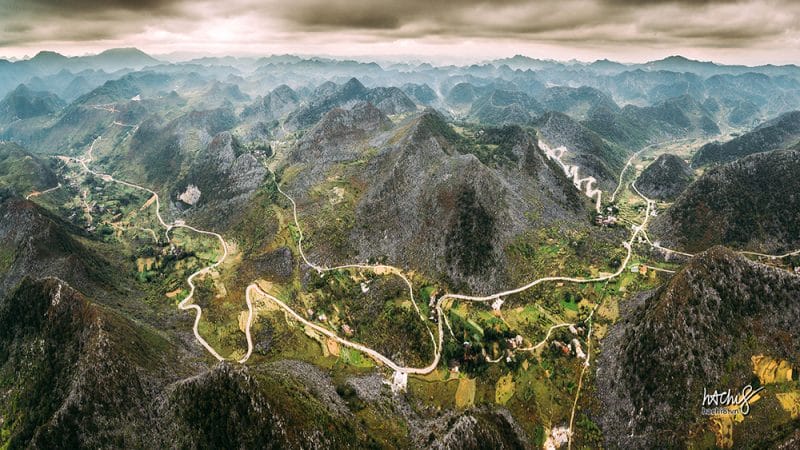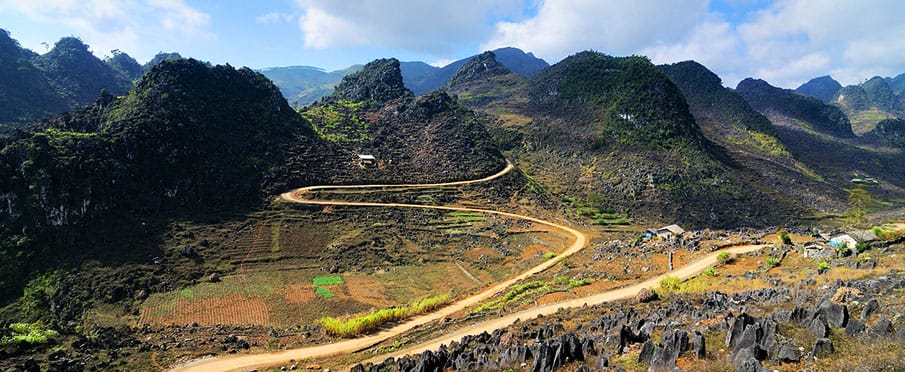From Ha Giang City, visitors travel on National Highway 4C for 43km to Quan Ba. Continuing on this highway through Can Ty Pass, pine forests, steep drops, deep ravines, and razor-sharp turns, visitors will reach to the karst plateau. Located on an altitude of 1,000m-1,600m, the 2,350km²- Dong Van Karst Plateau is one of Viet Nam’s special limestone areas, housing prominent imprints that depict the development of the earth’s crust. Up to 80% of the karst formations of Dong Van Plateau are limestone formed by environment conditions and different development stages of nature.

A survey conducted by scientists from the Viet Nam Institute of Geosciences and Natural Resources revealed the finding of 13 fossil – geological formations in Dong Van, including Chang Pung, Lutxia, Sika, Lang Xang, Si Phai, Toc Tat, Lung Nam, Bac Son, Dong Dang, Song Hien, Hong Ngai, Mia Le, and Lan Pang. Of which, Chang Pung is the oldest one with the date of 545 million years.
In addition, 19 paleontology groups were also discovered in Dong Van, including Brachiopoda (Tay Cuon), Trilobita (Bo Ba Thuy), Gastropoda (Chan bung), Foraminifera (Trung lo), Cephalopoda (Chan dau), Crinoidea (Hue Bien), Tentaculies (Vo Non), Conodonta (Rang Non), Tabulata (San ho vach day), Tetracoralla (San ho bon tia), Stromatoporoidea (Lo tang), Spirulina (Tao), Bryozoans (Dong Vat Dang Reu), Hydrilla verticillata (Thuc vat thuy sinh), Sclerotesta (Vo cung), Polybranchiaspis Liaojiaoshanensis (Ca Co), Pelecypoda (Chan Riu), Ancient Crustacean (Giap xac co) and Chitinozoa.
The paleontology groups have helped scientists draw a complete picture of development history in terms of geology of Dong Van Karst Plateau in particular and northeast Viet Nam and south China in general.
Thanks to weather changes and Dong Van’s geo-diversity, the karst evolution has created “rock gardens” and “rock forests” of diverse forms in the area, such as Khau Vai rock garden (Meo Vac) where you can contemplate the peaks of rocks in the shape of different kinds of flowers, Lung Pu rock garden (Meo Vac) with animal-shaped rocks such as tiger and dragon, Van Chai rock garden (Dong Van) with round flagstones arranged like thousands of black sea lions leaning one another getting some rest on the beach.

However, found commonly here are ranges of mountains running one after another to form pyramids heading up to skies. A system of caves and grottos found in the Dong Van Plateau provides a proof of the evolution of karst with Rong Cave in Sang Tung (Dong Van), Kho My Cave in Tung Vai (Quan Ba), En Grotto in Van Chai (Dong Van)…
The scientists have evaluated Dong Van Plateau as having a unique and diverse mountainous geo-ecosystem. Primitive forests here have been rather undamaged, habiting many rare floral species, including Burretiodendron Hsienmu (Nghien), Taxus Wallichiana Zucc (Thong do), Amentotaxus Hatuyenensis (De Tung Soc Nau), Cephalotaxus Hainanensis (Dinh tung), Podocarpus Pilgeri Foxw (Thong Tre La Ngan), Cupressus Funebris (Hoang Dan Ru)..,
Especially over 40 species of orchids. Dong Van Plateau also has a rich diversity of habitat for fauna as scientists have spotted over 50 species of wild animals, birds and reptiles in the site such as Capri Conrnis Sumatresis (Son Duong), Rhinopithecus Avunculus (Vooc Mui Hech), Sus Cristatus (Lon rung), Garrulax Canorus (Hoa mi)…
Besides geological, geomorphology and scenic values, Dong Van Karst Plateau reflects the traditional cultural richness of 17 ethnic minority groups, such as Mong, Dao, Lo Lo, Tay, Nung… These ethnic minorities have lived with the rocks. Here, the rock gardens dotted with green cornfields and golden rice fields. In addition Pho Bang, Dong Van, Lung Cu, Sa Phin markets coupled with time-honored ethnic festivals, rituals, customs and culture of local inhabitants weight the plateau’s unique charm.
Visiting Dong Van Plateau in the spring, you are hit by wonderful landscapes composed by yellow cai (kale) flowers and pink peach flowers in full blossom, mossy tiled roofs of stilt houses, dark green rocks and blue skies. Far in deep valleys covered by pure white plum flowers in full blossom hear remote sounds of khen (pan-flutes) of Mong people. The season covers rugged rocks and mountain peaks with its bright colors.
On 3rd October 2010, in Lesvos (Greece), Dong Van Karst Plateau was recognized as an official member of Global Geo-parks Network (GGN) for its prominent values on the landscape, palaeobiology, geology, geomorphology, and local culture. Dong Van Karst Plateau has become the first geo-park of Viet Nam and the second one in Southeast Asia (after Langkawi Geopark in Malaysia).






